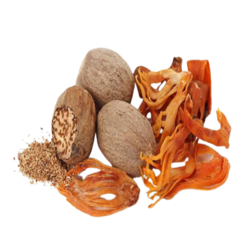Nutmeg & Mace are two distinctly different spices produced from a fruit of an evergreen tree usually 9-12 meter high. Mace is the dried reticulated ‘aril’ of the fruit and nutmeg is the dried seed kernel of the fruit. The trees are normally unisexual, bearing either male or female flowers. The male flowers are born in clusters, whereas female flowers are often solitary. Fruit is a fleshy drupe, spherical in shape, pale yellow in colour with a longitudinal groove in the centre. When the fruit mature it burst open along the groove exposing the bright attractive mace, covering the hard black, shiny shell caled Nutmeg, and mace is the net-like crimson leathery outer growth (aril) that covers the seed's shell. Indonesia, Grenada, Sri Lanka, Trinidad, China, and India are the primary producers.
Mace has a flavour comparable to nutmeg, although it is more refined. Mace is significantly more expensive than nutmeg. Mace of poor quality has no scent and is brittle. Both spices are used to flavouring both savoury and sweet meals, as well as as a medication. There is only 3-3.5kg of mace for every 100kg of nutmeg. The amount of volatile oil in mace determines its quality. Mace is available in whole, broken, and ground forms.Nutmegs are classified based on their size. Sizing can be done with various mesh sizes of sieves. Larger nutmegs (approximately 8g) are regarded excellent and command a greater price.

Origin & Distribution
Nutmeg tree is indigenous to Moluccas. The major nutmeg growing areas are Indonesia and Granada. It also grows on a smaller scale in Sri Lanka, India, China, Malaysia, Zanzibar, Mauritius and Solomon Island. Nutmeg thrives well in places with warm humid climate from sea level up to 600 mtrs MSL. It grows on a variety of soils from sandy to clayey loams and red laterite soils with good drainage. A well-distributed annual rainfall of 250 cm is ideal for the crop.
Uses
Both nutmeg and mace are used as condiment particularly in sweet foods. The spice in the ground form is mainly used in the food processing industry especially as a standard seasoning in many Dutch dishes. Nutmeg oleoresin is used in the preparation of meat products, soups, sauces, baked foods, confectionaries, puddings, seasoning of meat and vegetable etc. The fleshy outer cover of the fruit is crystallized or pickled or made into jellies. Mace is used in savoury dishes. It is used as a drug in Eastern countries because of its stimulant, carminative, astringent and aphrodisiac properties. Excessive doses have a narcotic effect. Nutmeg oil is used in cosmetics and toiletries.
